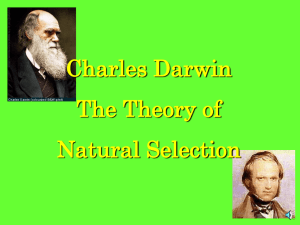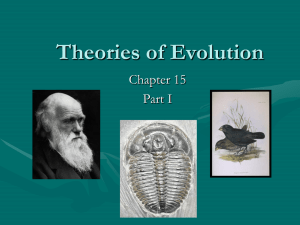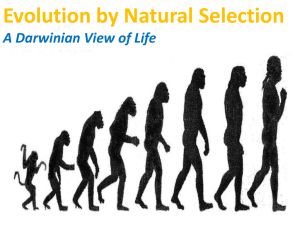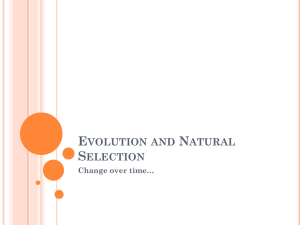File
advertisement
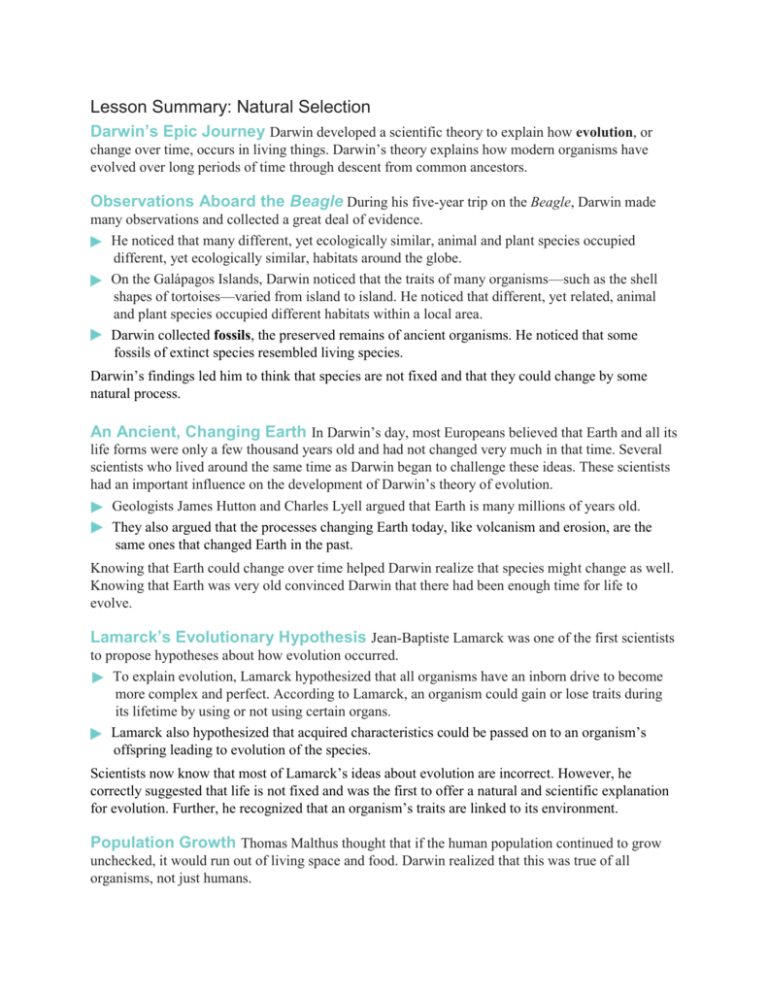
Lesson Summary: Natural Selection Darwin’s Epic Journey Darwin developed a scientific theory to explain how evolution, or change over time, occurs in living things. Darwin’s theory explains how modern organisms have evolved over long periods of time through descent from common ancestors. Observations Aboard the Beagle During his five-year trip on the Beagle, Darwin made many observations and collected a great deal of evidence. He noticed that many different, yet ecologically similar, animal and plant species occupied different, yet ecologically similar, habitats around the globe. On the Galápagos Islands, Darwin noticed that the traits of many organisms—such as the shell shapes of tortoises—varied from island to island. He noticed that different, yet related, animal and plant species occupied different habitats within a local area. Darwin collected fossils, the preserved remains of ancient organisms. He noticed that some fossils of extinct species resembled living species. Darwin’s findings led him to think that species are not fixed and that they could change by some natural process. An Ancient, Changing Earth In Darwin’s day, most Europeans believed that Earth and all its life forms were only a few thousand years old and had not changed very much in that time. Several scientists who lived around the same time as Darwin began to challenge these ideas. These scientists had an important influence on the development of Darwin’s theory of evolution. Geologists James Hutton and Charles Lyell argued that Earth is many millions of years old. They also argued that the processes changing Earth today, like volcanism and erosion, are the same ones that changed Earth in the past. Knowing that Earth could change over time helped Darwin realize that species might change as well. Knowing that Earth was very old convinced Darwin that there had been enough time for life to evolve. Lamarck’s Evolutionary Hypothesis Jean-Baptiste Lamarck was one of the first scientists to propose hypotheses about how evolution occurred. To explain evolution, Lamarck hypothesized that all organisms have an inborn drive to become more complex and perfect. According to Lamarck, an organism could gain or lose traits during its lifetime by using or not using certain organs. Lamarck also hypothesized that acquired characteristics could be passed on to an organism’s offspring leading to evolution of the species. Scientists now know that most of Lamarck’s ideas about evolution are incorrect. However, he correctly suggested that life is not fixed and was the first to offer a natural and scientific explanation for evolution. Further, he recognized that an organism’s traits are linked to its environment. Population Growth Thomas Malthus thought that if the human population continued to grow unchecked, it would run out of living space and food. Darwin realized that this was true of all organisms, not just humans. Artificial Selection Plant and animal breeders in Darwin’s time used a process now known as artificial selection to improve their crops and livestock. In artificial selection, nature provides the variations, and humans select those they find desirable. Darwin experimented with artificial selection. The results from his experiments indicated natural variation was very important because it provided the raw material for evolution. Evolution by Natural Selection Darwin published On the Origin of Species in 1859. In the book, Darwin describes and provides evidence for his explanation of how evolution occurs. He called this process natural selection because of its similarities to artificial selection. Darwin’s theory of evolution by natural selection can be summed up as follows: More offspring are produced than can survive to reproduce. There is competition for limited resources, or a struggle for existence. Individuals exhibit variation in their traits and some of these differences can be passed on to their offspring. Inherited traits that increase an organism’s ability to survive and reproduce are called adaptations. Differences among adaptations affect an individual’s fitness—the ability to survive and reproduce in a specific environment. Only the fittest organisms live to reproduce and pass on their adaptive traits to offspring. This is known as the survival of the fittest. From generation to generation, populations continue to evolve as they become better adapted, or as their environment changes. Common Descent Darwin argued that all species are descended, with modification, from common ancestors. Through descent with modification, all organisms—living and extinct— are linked on a single tree of life.


